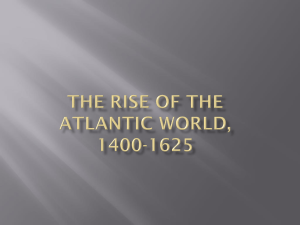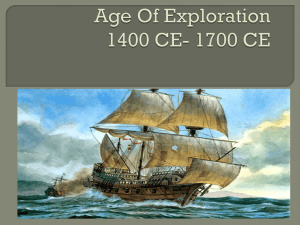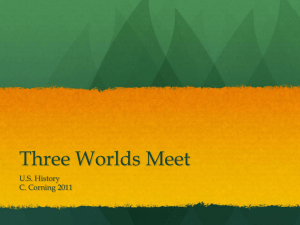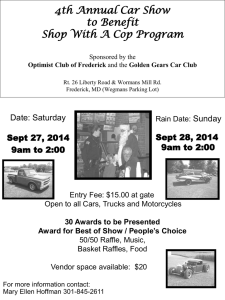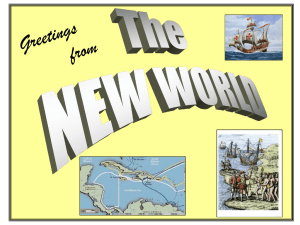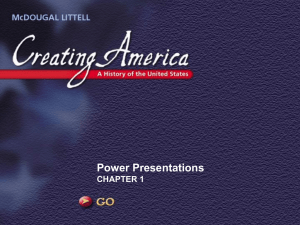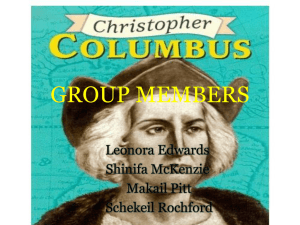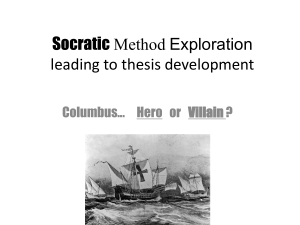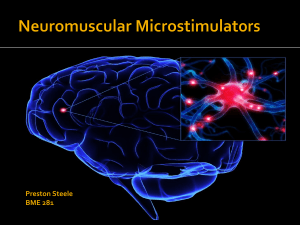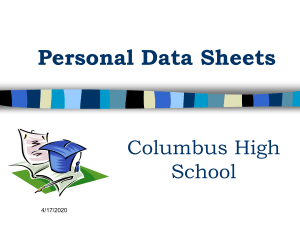European Societies Around 1492
advertisement
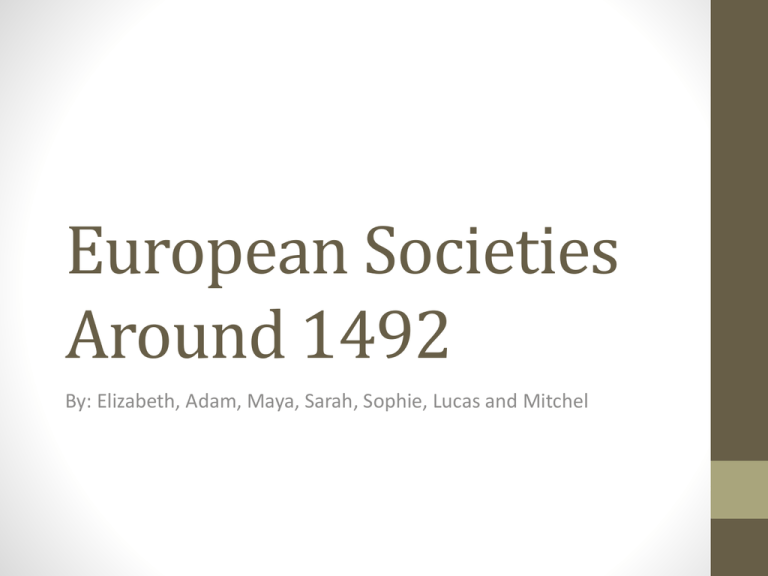
European Societies Around 1492 By: Elizabeth, Adam, Maya, Sarah, Sophie, Lucas and Mitchel Religion • Roman Catholic Church dominates; pope, bishops make decisions • Parish priests interpret scriptures, administer sacraments Crusading Christianity • Crusades—Christian military expeditions to take Holy Land, 1096–1270 • Isabella, Ferdinand end reconquista or reconquest of Spain,1492 • Crusades led to decreased power for the Pope, increased power for European monarchs, and increased trade between Europe and Asia Decline in Church Authority • Reformation—disputes over church practices, authority in the 1500s • Europe divided between Catholicism and Protestantism Politicics • European societies were based • Majority pop. was Peasants on social hierarchy • Supplied with land and • Monarchs and Nobles controlled protection in return for livestock the wealth and power or crops • Never rise above Social class you • Traders gained Social Mobility were born in Trade and Geography How the geography of Europe affected the development and advancement of the trade. The Geography of Europe in 1492 The Geography of Europe in 1492 Present Day Europe Present Day World Why was Europe’s Location VITAL for Successful Trade? • Europe is located next to many, many bodies of water: • The Mediterranean Sea • The Atlantic Ocean • The North Sea • The Black Sea • The Baltic Sea • The Norwegian Sea Therefore… • Because Europe was located in close proximity to Asia, North America, South America, Africa, and even the Middle East, European people, like Christopher Columbus, were able to to travel to many different lands using different forms of transportation. • When Christopher Columbus discovered other lands, like AMERICA, Europe’s trade and knowledge was able to expand greatly, then went on many other voyages to expand Europe’s knowledge of the ‘new world’ that awaited them • This exploration and resulted in: • Cultural Diffusion • Advanced Technology and Cities • An Economically Stable Government due to riches, prosperous lands, and trade that started to be exploited • Exploring and discovering of Different Lands, Continents, and Trade Routes • Specialization of Jobs and Labor (explorers, merchants…) Meet Christopher Columbus • This short video will introduce you to Christopher Columbus, and will allow all of you to see why he was such an asset to Europe, and how he led Europe on it’s path of trade and advancement • Christopher Columbus discovered these ‘new worlds’: • ‘Asia’ (Americas) • Cuba • Hispaniola • Caribbean • http://www.youtube.com/watch?v=oSJKoOaRZmE European Trade Routes in 1492 European Trade Routes in 1492 Trade in Europe • At this time (1492): • There was trade in the Middle East, Europeans traded goods for silk, cloth, and spices • Europe traded with the Americas for whale oil, lumber, furs, rice, silk, indigo, tobacco, sugar, molasses, and wood. In return, Europe gave the Americas luxuries and manufactured goods • Europe traded guns, cloth, iron, and beer, in return for gold, ivory, spices, and hardwoods from Africa • Christopher Columbus first came to the Americas in 1492 while seeking the West Indies which allowed for the slave trade to begin: • Slaves from West Africa, Central Africa, American Indians, and South Americans were shipped over to the ‘new world’ • Then, Europeans would sell the slaves to one another, making a profit; thus, earning the name, ‘the slave trade’ GROWTH OF COMMERCE • The first people documented to have profited from trade with Asians were Italian merchants from Venice and Florence. • This led to the revolutionary business institutions being created: international banks and corporations. International banking allowed people to transfer their money to different cities. Corporations were joint-stock companies, which meant investors could put together their riches. • Of important significance is especially the development of the joint-stock companies, because they financed the expeditions to America. Popular wanted items from the East • • • • Chinese silk and porcelain Tea from India Persian rugs Spices (Pepper, Curry, cinnamon, nutmeg, etc.) Factors that affected the economy • POPULATION: The population was steadily increasing during the 1400’s, resulting in a rise in prosperity, towns growing as well as the growth in commerce. Rise in population meant less land; thus making land worth more. Now the rich landowners could spend more money on goods, which caused an rise in economic growth and increased trade that benefitted all merchants. Also, more peasants were forced to look for work in the city due to rents rising. • RISE OF NATIONS: With the crusades weakening the nobles, this gave the monarchs the opportunity to have more control over their land. To do this they introduced new taxes, raised armies and made stronger central governments. By investing some of their tax income into weaponry, the monarchs arsenal could overpower anyone who opposed them; whether it was Native Americans or Africans. Motives behind funding explorers • Only kings/queens from powerful nations like Spain, Portugal, France, and England had the money and power to fund overseas exploration. • They funded out of hope the new land would have valuable resources, seeing as gold and silver were scarce in Europe during the mid 1400’s. • Also the “Renaissance Spirit”, giving people the drive to seek out glory, fame and achievements. • Other motives: New land, slaves, etc. RENAISSANCE SPIRIT • “Renaissance” = rebirth • A rekindling of people’s curiosity and craving for knowledge of the world inspired people to think differently. People started to value education, science, the arts, and achievement. • Said to have started in the 1450’s especially after Gutenberg released the printing press and scholars rediscovering ancient documents. • Printing press resulted in books being produced quicker and being sold cheaper. Military • The Crusades weakened the nobility and therefore strengthened the monarchies. Monarchs began to exert more control over their land and people, and among the changes was the need to raise professional armies. • Big, professional armies are very expensive, and the need for resources and supplies grew with the number. Therefore monarchs had a motive to encourage the quest for new land and trading routes, so that the profit could maintain their standing armies. • Advances in maritime technology also affected European militaries. The invention of the caravel, a lighter, swifter, and more maneuverable ship and other navigational inventions such as the compass and the astrolabe resulted in more military control in the seas adjacent to Europe. • Though the Chinese had introduced gunpowder to Europe before this time, Europeans continued to refine the formulae and find new uses for it, which was put to use with their militaries. New Age of Expansion • New communication and trade routes • First global businesses • New technologies • Foods • Death of Native Americans • Rising slavery New Age of Expansion • Portugal created a sailing school by Prince Henry. • Explored further around Africa • In 1488 the whole African coast was fully discovered by Portuguese. • Columbus began his search to find a faster rout to Asia in 1492. • Columbus’s ship ‘Pinta’ was a carvel. New Age of Expansion-Exports • Foods : • • • • • Tomato Potato Peanut Corn Cassava • Foods : • Cotton • Tobacco • Indigo Rise of Nations • Crusades weakened the society and monarchies. • Western Europe monarchs began to take more control of the lands • Collecting more taxes, raising the number of armies, and strengthening their governments. • Merchants were willing to pay the new taxes, but in exchange for protection, expansion or trade. • By the 1400s the four major nations that were taking a new form are: Portugal, Spain, France, and England. Rise of Nations • Monarchs increased power investing some tax revenues in new weapons used to limit the power of the independent nobles. • In the 1400s the major weapons were developed more and would also eventually outmatch the weapons of the Africans and Native Americans. • Only the king and queen of a nation were given the power to finance overseas explorations. • Trading was encouraged to maintain a standing army. • By the mid 1400s Europe’s gold and silver mines were running low. That’s when the monarchs of Spain, France and England started looking overseas for wealth. Bibliography • "258E Behaim's Globe Outline Superimposed on Modern Map." Henry Davis Consulting - New Products and Marketing Consultants. Web. 03 Sept. 2011. <http://www.henry-davis.com/MAPS/LMwebpages/258E.html>. • "The Atlantic World." The Atlantic World, 1492-1800. Web. 1 Sept. 2011. <http://mclane.fresno.k12.ca.us/wilson98/mwh/C/MH04C017.PDF>. • "BeHaim's Globe 1492." Web. 31 Aug. 2011. <https://www.collegeofidaho.edu/academics/history/PP/102PP/WCivEMLct1 6BEuro%20Expansion.htm#slide0134.htm>. • "Classic Cartoons - Christopher Columbus - YouTube." YouTube - Broadcast Yourself. Web. 03 Sept. 2011. <http://www.youtube.com/watch?v=oSJKoOaRZmE>. • "Europe Claims America: The Atlantic Joined." Library of Congress Home. Web. 03 Sept. 2011. <http://www.loc.gov/exhibits/1492/eurocla.html>. • "European Expansion: The Colombian Encounter." News & Events : Department of History : University of Minnesota. Web. 30 Aug. 2011. <http://www.hist.umn.edu/shank/hum003/HumIII2005_Lecture14.html>. Bibliography • "European Societies Around 1492." European Societies Around 1492. Web. 2 Sept. 2011. <European Societies Around 1492>. • "Indigenous Slavery in South America, 1492–1820 (Neil L. Whitehead) - Academia.edu." University of Wisconsin-Madison Academia.edu. Web. 02 Sept. 2011. <http://wisc.academia.edu/NeilWhitehead/Papers/287591/Indigeno us_Slavery_in_South_America_1492-1820>. • "Medieval Europe 476 AD - 1492 AD - History Forum ~ WorldHistoria - Page 1." History Forum ~ WorldHistoria. Web. 30 Aug. 2011. <http://www.worldhistoria.com/medieval-europe-476-ad-1492ad_forum63.html>. • "Slavery Timeline 1400-1500 - a Chronology of Slavery, Abolition, and Emancipation." Brycchan Carey - Home Page. Web. 31 Aug. 2011. <http://www.brycchancarey.com/slavery/chrono2.htm>. • "The Spanish Expulsion, 1492." Jewish Virtual Library - Homepage. Web. 01 Sept. 2011. <http://www.jewishvirtuallibrary.org/jsource/Judaism/expulsion.htm l>. • Travel Europe. Web. 1 Sept. 2011. <http://www.travel-europe.info/>. Bibliography • "Worldpress.org - Map of the World." Worldpress.org - World News From World Newspapers. Web. 05 Sept. 2011. • "The New Foods Discovered While Exploring the Americas - by Nancy Seddens - Helium." Helium. Web. 05 Sept. 2011. <http://www.helium.com/items/1796943-what-new-food-werefound-in-the-new-world>. • Holmes, Lin. "LJ HOLMES PRESENTS: THE KING OF SILK." Lin Holmes' Blog. Web. 05 Sept. 2011. <http://linsownblog.blogspot.com/2010/07/cover-day-keepsskeptics-away-siete.html>. • Mean, That I. "What Are the Major Diffrences between Asian, North American, and European Cities? - SkyscraperCity." SkyscraperCity. Web. 05 Sept. 2011. <http://www.skyscrapercity.com/showthread.php?t=675366>. • "The Middle Ages." ELibrary.SD71 - School District #71 (Comox Valley). Web. 05 Sept. 2011. <http://elibrary.sd71.bc.ca/subject_resources/socials/middleagesfra me.htm>.
